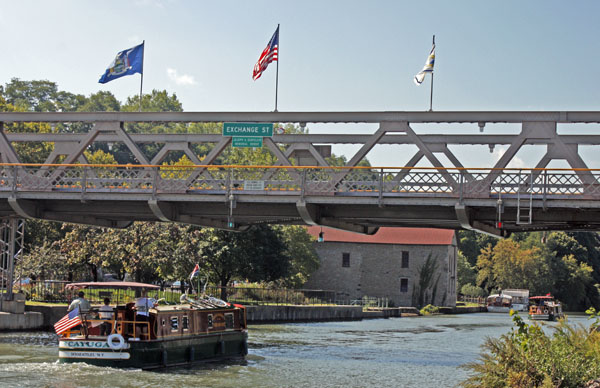September 14, 2010
Today I start my 360-mile trek along the Erie Canalway Trail from Lockport, New York to Albany, New York. I begin my journey at Exchange Street in Lockport, New York where I view a double canal lock. Two boats heading east pass through Locks 34 & 35 and are lowered to a new level. They continue their journey along the canal. If they travel the entire length of the canal, they will pass through fifty-seven locks.
I start cycling along the canal on a packed, crushed limestone trail. The muddy brown waters of the canal flow by me on the right. Houses sit along the road on my left. I pick up my pace and soon find myself on the outskirts of Lockport. I pass by an expansive apple orchard on my left. When I look across the canal, I spot soybeans in the distance.
I think back to 1825 when mules walked along the towpaths and pulled boats along the canal. At the time, the canal was the engineering marvel of its day. The canal was built to open the country west of the Appalachian Mountains to settlers and to offer a cheap and safe way to carry produce to market. On July 4, 1817, Governor Dewitt Clinton broke ground for the construction of the canal, known as “Clinton’s Ditch”.
When finally completed on October 26, 1825, it included 18 aqueducts to carry the canal over ravines and rivers, and 83 locks, with a rise of 568 feet from the Hudson River to Lake Erie. It was 4 feet deep and 40 feet wide, and floated boats carrying 30 tons of freight. A ten- foot wide towpath was built along the bank of the canal for horses, mules, and oxen. In order to keep pace with the growing demands of traffic, the Erie Canal was enlarged between 1836 and 1862. The new canal was 70 feet wide and 7 feet deep, and could handle boats carrying 240 tons. The number of locks was reduced to 72.
In 1903, the state again decided to enlarge the canal by the construction of what was called the “Barge Canal”. The resulting canal was completed in 1918, and was 12 feet deep, 120 to 200 feet wide, and 363 miles long, from Albany to Buffalo. With 57 locks, it was built to handle barges carrying up to 3,000 tons of cargo. Today the Erie Canal is utilized largely by recreational boats rather than cargo-carrying barges.
In six miles, I arrive in Gasport named after a spring emitting coal gas. The town has two lift bridges, which span the canal. Between 1905 and 1918, lift bridges became a common site along the western portion of the Erie Canal. When a canal boat approached, it alerted the bridge operator with three horn blasts. The operator stopped the traffic on the roadway by lowering a gate. Then using underground machinery, he lifted the deck of the bridge ten feet in the air so that boats and barges could pass through.
Two miles east of the town of Medina, I cycle by the Medina Culvert. This is where the Erie Canal flows over Culvert Road. It is the only place along the New York canal system where a road crosses under the canal. The culvert built in 1823 leaks. There’s constant water dripping in the middle section directly under the canal. In the town of Knowlesville, I meet a woman walking her beagle named Sara. The pathway is a popular place to take Fido for a walk. Big dogs, little dogs, puppies, seniors, dogs wearing bandanas, dogs with decorative collars, and dogs carrying sticks all walk along the water.
The trail elevates me above the canal. From my vantage point, I see apple orchards, rows of red tomatoes and fields of green cabbage. Up ahead I see a gaggle of white geese carousing in the middle of the path. As I cycle closer they honk in protest then waddle into the canal.
Outside the town of Brockport, the path narrows and I start cycling through woods. A canopy of trees hovers over the pathway and blocks the sun. I arrive in the town of Greece and ride quietly through Henpeck Park. Near Genesee Valley Park, one can see where the Erie Canal crosses the Genesee River. At one time, the Erie Canal flowed over the Genesee River in an aqueduct.
I arrive in Fairport, New York where my route ends and our layover begins. We spent an awesome layover day with my Mother, my sister Karen and her family, and my brother Bill and his wife Diane. I had a special visit from my college friend Kathy who I hadn’t seen in twenty-four years. Thanks all for a wonderful relaxing time.
God Bless,
Kathy
Philippians 4:6-7








